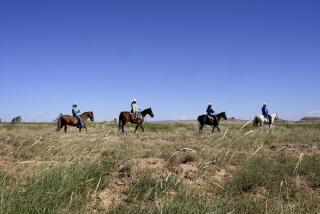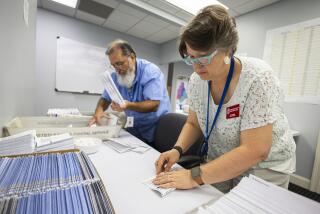Hours-long lines, goofs with ballot materials. Why can’t Arizona hold elections?
Reporting from PHOENIX — When the Supreme Court threw out major elements of the Voting Rights Act three years ago, Maricopa County in Arizona moved quickly to lower the cost of holding elections.
Among its first moves was to reduce the number of polling centers from 200 to 60. With fewer locations, the state allowed voters to choose any polling station in the county. The hope was to make voting more convenient and encourage more people to cast their ballots by mail.
It hasn’t turned out that way.
The result: stories of having to wait five hours to vote in the March primary election for president, a call to impeach Arizona’s secretary of state, three lawsuits and a Justice Department inquiry.
See the most-read stories this hour >>
“I don’t know what the right word is to express it,” Arizona Atty. Gen. Mark Brnovich said at a news conference Thursday, speaking of his anger at the situation “as an Arizonan and as attorney general.”
Arizona has an ugly history with elections. Native Americans were long forbidden from voting because the state considered them “wards of the nation.” The state once required residents to pass a literacy test in order to vote and refused to print election materials in languages other than English.
In 1972, federal elections officials labeled Arizona one of nine problem states, along with Alaska and several in the Deep South, that were required to submit all potential changes in election law to the Justice Department for preclearance to ensure they did not unfairly target minorities.
The Supreme Court eliminated that requirement in the 2013 case Shelby County vs. Holder, clearing the way for Maricopa County — where 40% of voters are minorities — to change its elections laws without federal oversight.
On election night March22, the waits in Maricopa County — the state’s most populous — felt interminable. The line in front of the Church of the Nazarene in Maryville stretched to 700 people.
In April, the Justice Department asked Maricopa County for data on the county’s decision to cut the number of polling places.
Secretary of State Michele Reagan, who oversees elections, is also taking heat for failing to ensure that 400,000 voters received election publicity pamphlets that spelled out the pros, cons and costs of a pair of ballot measures scheduled to be considered in a special election May 17.
Tom Ryan, an attorney from Chandler, Ariz., a leading opponent of an education measure on the ballot, on Friday called for Reagan’s impeachment.
Brnovich too raised questions about her handling of the election. “When did the secretary of state know about this, and why did it take weeks in order to inform the public or [make] a complaint [to] get this information forward?” he said Thursday.
But with more than 700,000 early ballots already cast, Brnovich has rejected calls to postpone the election.
“We don’t want to disenfranchise people that have already voted,” he said. “To me, I’m as frustrated as anyone.... I want to go into court. I wish there was a better remedy.”
Reagan said through a spokesman that the problem with the pamphlets was uncovered three weeks ago and was the fault of the vendor, IBM. She has not said why she waited to disclose the problems.
One voter who spent more than five hours in a line on March 22 was Kimberly Yee, a Republican state senator who was so appalled that she introduced a bill to establish a minimum number of polling places in each county. But the state Legislature did not take up the measure before the end of its session.
“In a year when most states experienced record or near-record turnout,” said Michelle Ugenti-Rita, a Scottsdale Republican and chair of the House Elections Committee, “Arizona should have been better prepared and anticipated the amount of turnout we experienced.”
ALSO
U.S. intelligence warns of Venezuela collapse
I loved Uber as a passenger. Then I starting working as a driver
This is how Gov. Brown wants to make it easier to build affordable housing
More to Read
Sign up for Essential California
The most important California stories and recommendations in your inbox every morning.
You may occasionally receive promotional content from the Los Angeles Times.











